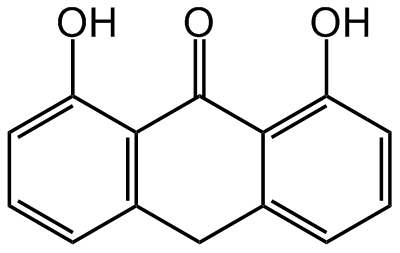Anthralin
| Code | Size | Price |
|---|
| CDX-D0308-G001 | 1 g | £84.00 |
Quantity:
| CDX-D0308-G005 | 5 g | £304.00 |
Quantity:
Prices exclude any Taxes / VAT
Overview
Regulatory Status: RUO
Shipping:
AMBIENT
Storage:
-20°C
Images
Documents
Further Information
Alternate Names/Synonyms:
Dithranol; 1,8-Dihydroxyanthrone; Anthracene-1,8,9-triol; NSC 43970; NSC 629313
Appearance:
Faint yellow to yellow powder.
CAS:
1143-38-0
EClass:
32160000
Form (Short):
liquid
GHS Symbol:
GHS07
Handling Advice:
Keep cool and dry.Protect from light and moisture.
Hazards:
H315, H319, H335
InChi:
InChI=1S/C14H10O3/c15-10-5-1-3-8-7-9-4-2-6-11(16)13(9)14(17)12(8)10/h1-6,15-16H,7H2
InChiKey:
NUZWLKWWNNJHPT-UHFFFAOYSA-N
Long Description:
Chemical. CAS: 1143-38-0. Formula: C14H10O3. MW: 226.2. Synthetic. Anthralin is a leukotriene biosynthesis inhibitor. It inhibits LTB4 omega-oxidation and disrupts mitochondria function. Anthralin is used in the treatment of psoriasis, as a fungicide, in the treatment of ringworm infections and in chronic dermatoses. It accumulates in mitochondria where it interferes with the supply of energy to the cell, probably by the oxidation of dithranol releasing free radicals. This impedes DNA replication and so slows the excessive cell division that occurs in psoriatic plaques. Numerous studies have demonstrated anti-proliferative and anti-inflammatory effects of anthralin on psoriatic and normal skin. It is also used as matrix substance for MALDI-MS (matrix-assisted laser desorption ionization MS).
MDL:
MFCD00053409
Molecular Formula:
C14H10O3
Molecular Weight:
226.2
Package Type:
Vial
Precautions:
P261, P305, P351, P338
Product Description:
Anthralin is a leukotriene biosynthesis inhibitor. It inhibits LTB4 omega-oxidation and disrupts mitochondria function. Anthralin is used in the treatment of psoriasis, as a fungicide, in the treatment of ringworm infections and in chronic dermatoses. It accumulates in mitochondria where it interferes with the supply of energy to the cell, probably by the oxidation of dithranol releasing free radicals. This impedes DNA replication and so slows the excessive cell division that occurs in psoriatic plaques. Numerous studies have demonstrated anti-proliferative and anti-inflammatory effects of anthralin on psoriatic and normal skin. It is also used as matrix substance for MALDI-MS (matrix-assisted laser desorption ionization MS).
Purity:
>98% (HPLC)
Signal word:
Warning
SMILES:
OC1=CC=CC2=C1C(=O)C1=C(O)C=CC=C1C2
Solubility Chemicals:
Soluble in acetone.
Source / Host:
Synthetic.
Transportation:
Non-hazardous
UNSPSC Category:
Biochemical Reagents
UNSPSC Number:
12352200
Use & Stability:
Stable for at least 2 years after receipt when stored at -20°C.
References
(1) R.E. Ashton, et al.; J. Am. Acad. Dermatol. 9, 173 (1983) | (2) J.M. Schr?der; J. Invest. Dermatol. 87, 624 (1986) | (3) C.E. Orfanos, et al.; Drugs 34, 459 (1987) (Review) | (4) L. Kemeny, et al.; Skin Pharmacol. 3, 1 (1990) | (5) K. M?ller; Biochem. Pharmacol. 53, 1215 (1997) (Review) | (6) K. Pavithran; Indian J. Dermatol. Venereol. Leprol. 67, 104 (2001) | (7) C.H. Le, et al.; Anal. Chem. 84, 8391 (2012) | (8) C. Ronpirin & T. Tencomnao; Genet. Mol. Res. 11, 412 (2012) | (9) S.E. George, et al.; J. Pharm. Pharmacol. 65, 552 (2013)
Related Products
| Product Name | Product Code | Supplier | Ferimzone | CDX-F0081 | Chemodex | Summary Details | |||||||||||||||||||||||||||||||||||||||||||||||||||||||||||||||||||||||||||||||||||||||||||||
|---|---|---|---|---|---|---|---|---|---|---|---|---|---|---|---|---|---|---|---|---|---|---|---|---|---|---|---|---|---|---|---|---|---|---|---|---|---|---|---|---|---|---|---|---|---|---|---|---|---|---|---|---|---|---|---|---|---|---|---|---|---|---|---|---|---|---|---|---|---|---|---|---|---|---|---|---|---|---|---|---|---|---|---|---|---|---|---|---|---|---|---|---|---|---|---|---|---|---|---|
| Flusulfamide | CDX-F0082 | Chemodex | Summary Details | ||||||||||||||||||||||||||||||||||||||||||||||||||||||||||||||||||||||||||||||||||||||||||||||||
| Isoprothiolane | CDX-I0048 | Chemodex | Summary Details | ||||||||||||||||||||||||||||||||||||||||||||||||||||||||||||||||||||||||||||||||||||||||||||||||



